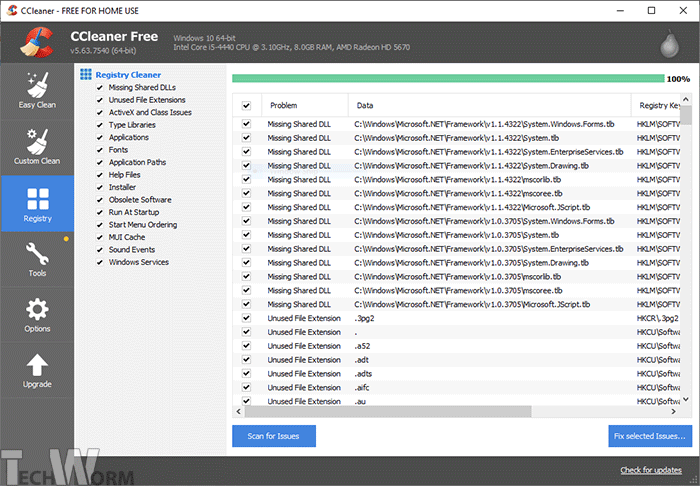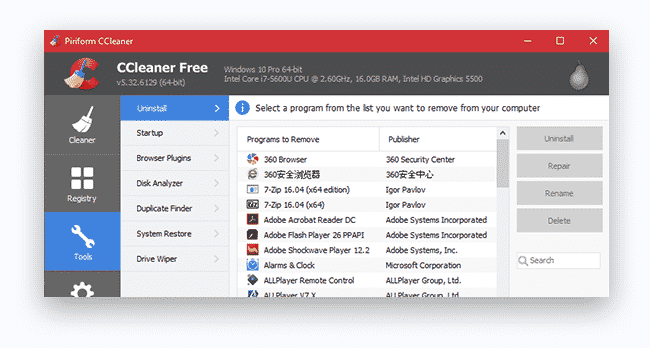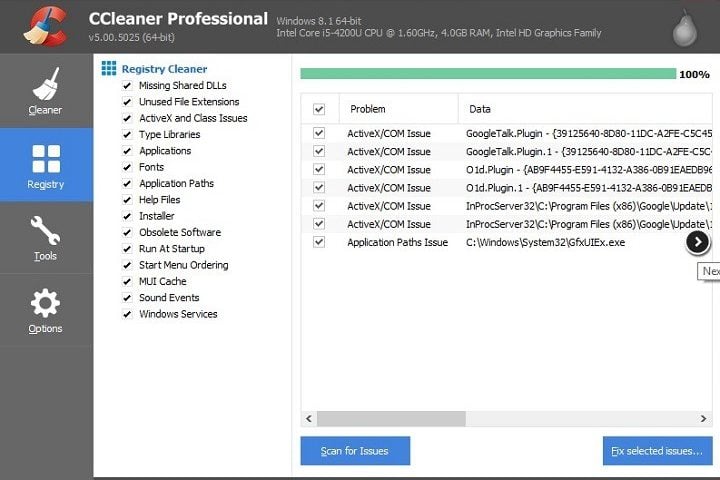

- #Ccleaner windows 10 uninstalled how to#
- #Ccleaner windows 10 uninstalled install#
- #Ccleaner windows 10 uninstalled zip file#
- #Ccleaner windows 10 uninstalled code#
- #Ccleaner windows 10 uninstalled zip#
\Deploy-CCleaner.ps1 -DeploymentType "Uninstall" -DeployMode "NonInteractive" \Deploy-CCleaner.ps1 -DeploymentType "Install" -DeployMode "Interactive" \Deploy-CCleaner.ps1 -DeploymentType "Install" -DeployMode "Silent"

\Deploy-CCleaner.ps1 -DeploymentType "Install" -DeployMode "NonInteractive"
#Ccleaner windows 10 uninstalled install#
If 3010 is passed back to SCCM, a reboot prompt will be triggered.Ĭhanges to "user install mode" and back to "user execute mode" for installing/uninstalling applications for Remote Destkop Session Hosts/Citrix servers.ĭisables logging to file for the script.
#Ccleaner windows 10 uninstalled code#
NonInteractive mode is automatically set if it is detected that the process is not user interactive.Īllows the 3010 return code (requires restart) to be passed back to the parent process (e.g. Options: Interactive = Shows dialogs, Silent = No dialogs, NonInteractive = Very silent, i.e. Specifies whether the installation should be run in Interactive, Silent, or NonInteractive mode. The script dot-sources the AppDeployToolkitMain.ps1 script which contains the logic and functions required to install or uninstall an application. The install deployment type is broken down into 3 main sections/phases: Pre-Install, Install, and Post-Install. The script either performs an "Install" deployment type or an "Uninstall" deployment type. The script is provided as a template to perform an install or uninstall of an application(s).

Next we’ll want to download the EXE installer for CCleaner. You should now see the AppDeploymentToolkit folder with files & the empty Files folder at “C:\Downloads\CCleaner”

#Ccleaner windows 10 uninstalled zip#
#Ccleaner windows 10 uninstalled zip file#
Download the zip file to a folder created at (C:\Downloads).Download the Powershell App Deployment Toolkit 3.8.4:.
#Ccleaner windows 10 uninstalled how to#
How to Install CCleaner Using the PowerShell App Deployment Toolkit This tool is an absolute must for Microsoft Endpoint Manager Configuration Manager (MEMCM) / (SCCM) Administrators or anyone who is responsible for packaging and deploying software. The PowerShell App Deployment Toolkit can be used to replace your WiseScript, VBScript and Batch wrapper scripts with one versatile, re-usable and extensible tool. It does seem to be caused by deleteing windows.old and there are other reports of this problem on Insiders Feedback (all associated with CCleaner.) From other's I have heard there is no problem if you use the built in "Disc Clean" to delete windows.old or if you wait 30 days and let Windows automatically remove the folder? Personally, I don't have that much patience.This article will serve as an informative guide and give you a clear understanding of how to perform silent or interactive installs and uninstalls of CCleaner using the Powershell App Deployment Toolkit. The installs are straight forward and fast.Įdit: Oh and once the Apps have been re-installed you can apparently run CCleaner without problems.Ĭan anyone confirm if this is a CCleaner problem or a Windows 10 issue. Search on "Microsoft" and most Apps will be found, sometimes you must search on "Windows" and occasionally you may need the specific name that shows on the Start Menu. You may need to search for particular App if it doesn't already appear in your Library. Follow the instructions and the removals are pain free.Īfter Removing the Apps it is usually necessary to reboot before the Store allows you to install again. The thing of it is, most of the affected Apps can't be Uninstalled via the Start Menu or Settings so you have to user PowerShell to "Remove" the Apps. The only fix I found is to remove the broken apps and re-install from the Store.


 0 kommentar(er)
0 kommentar(er)
